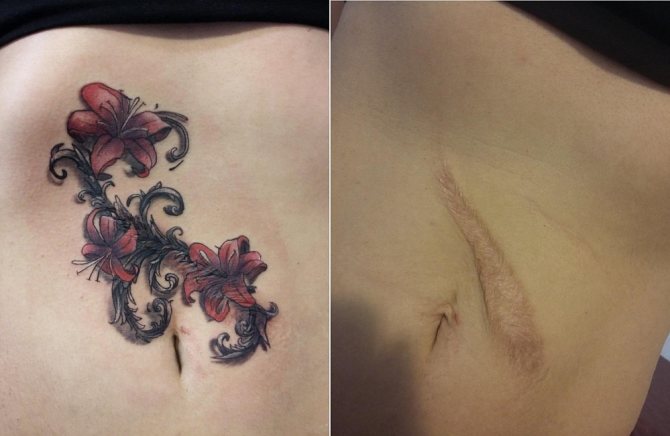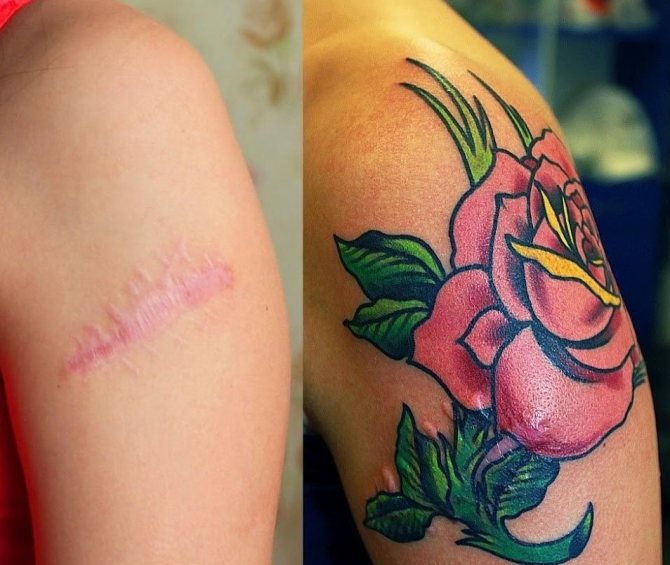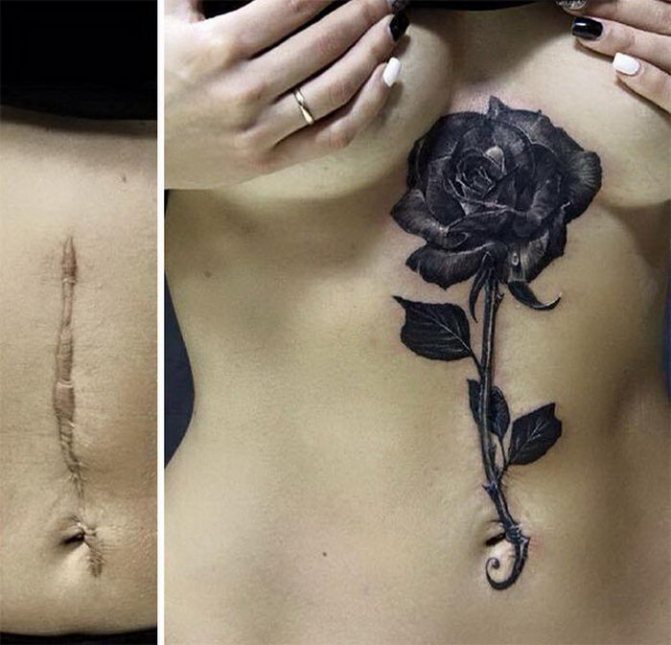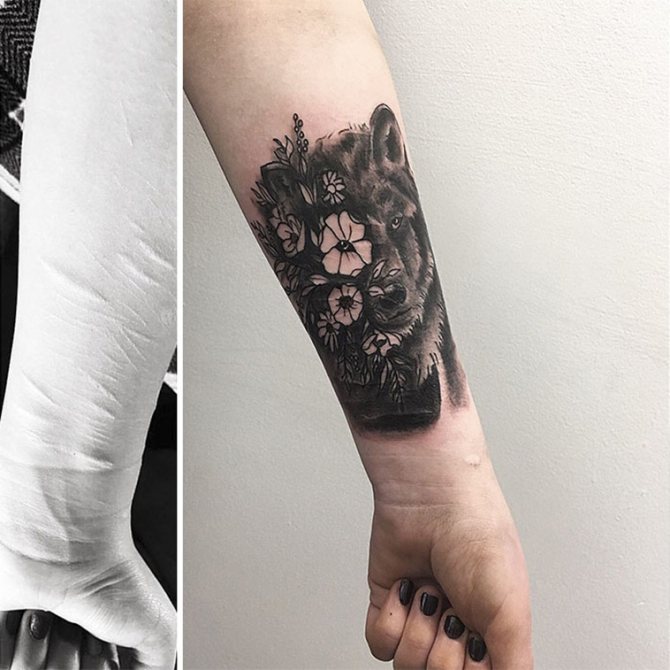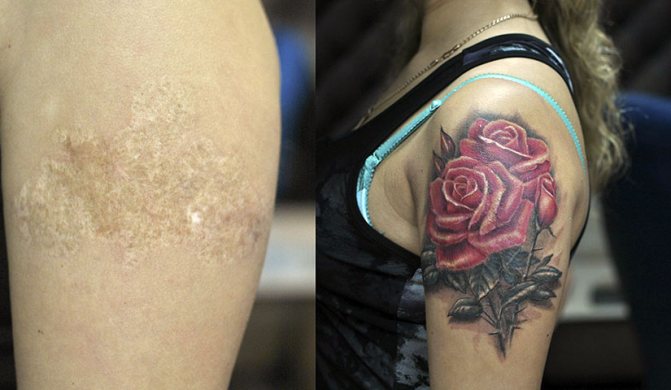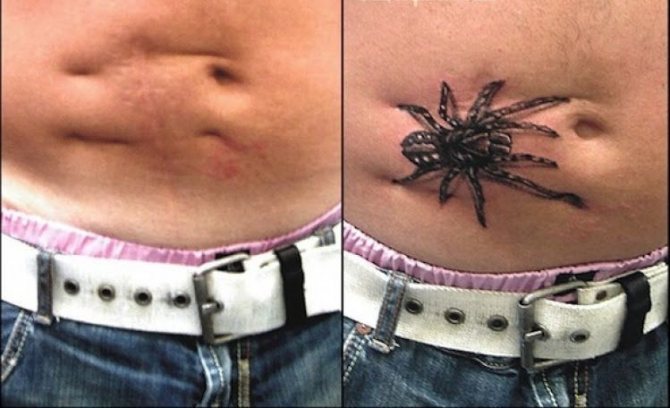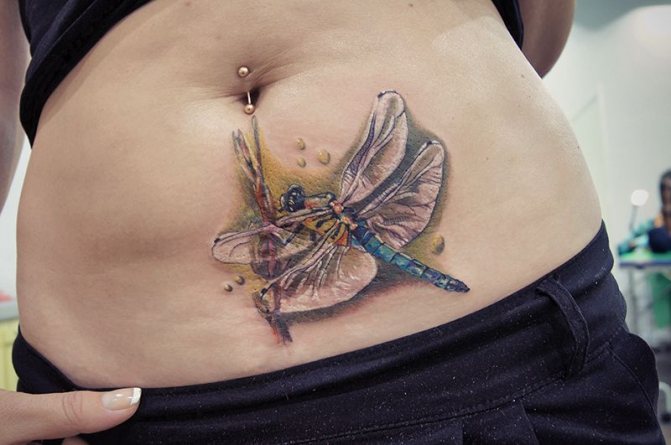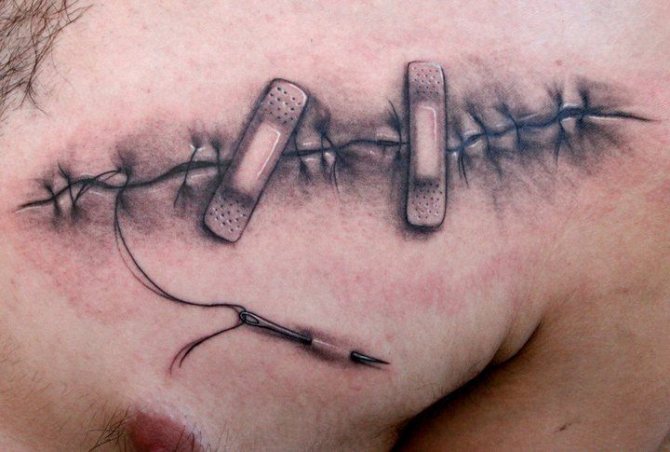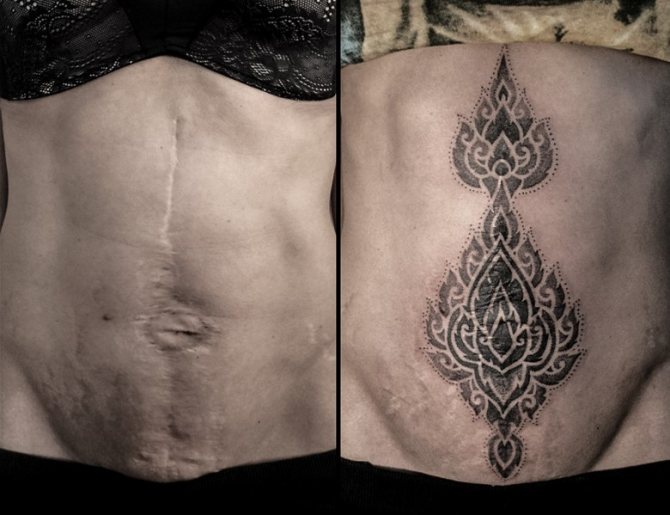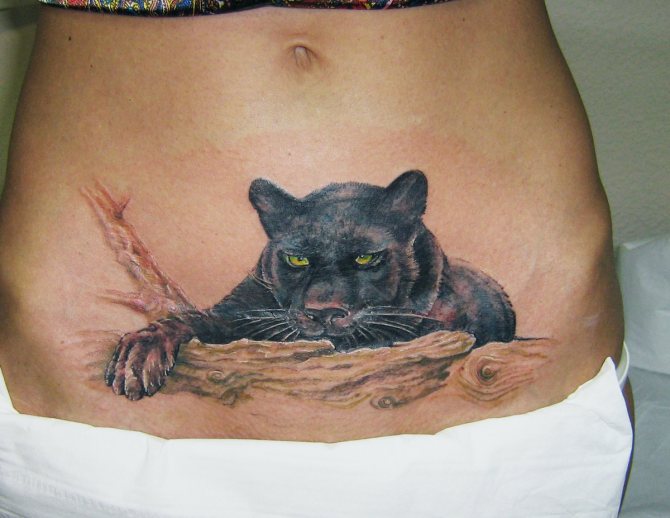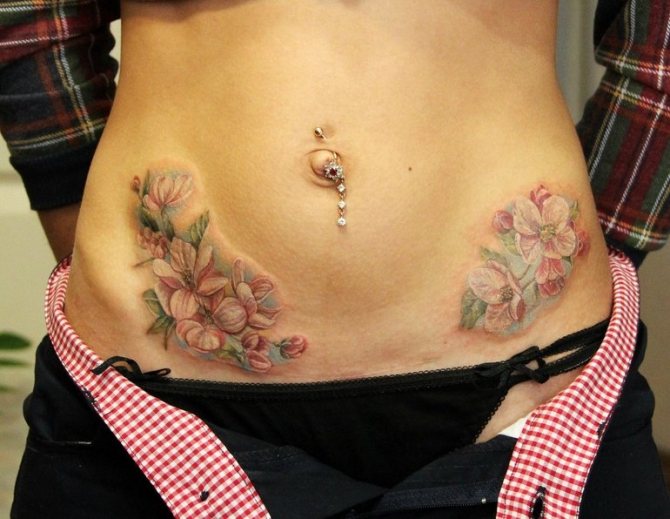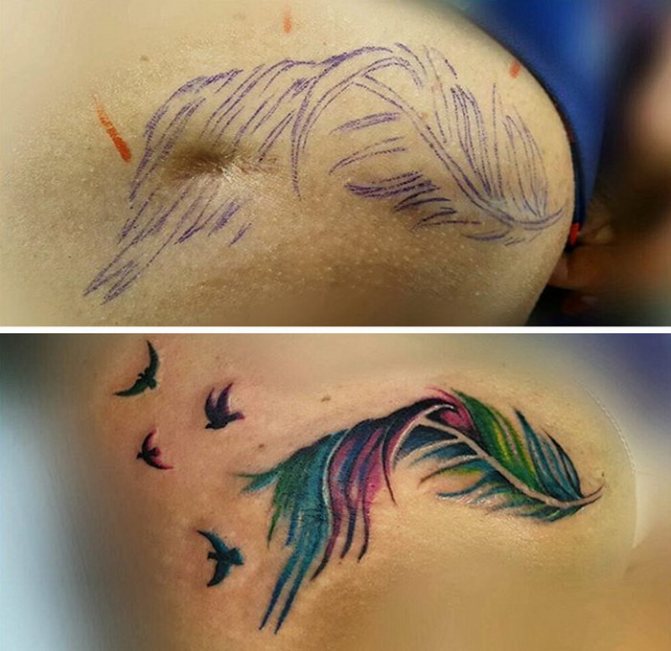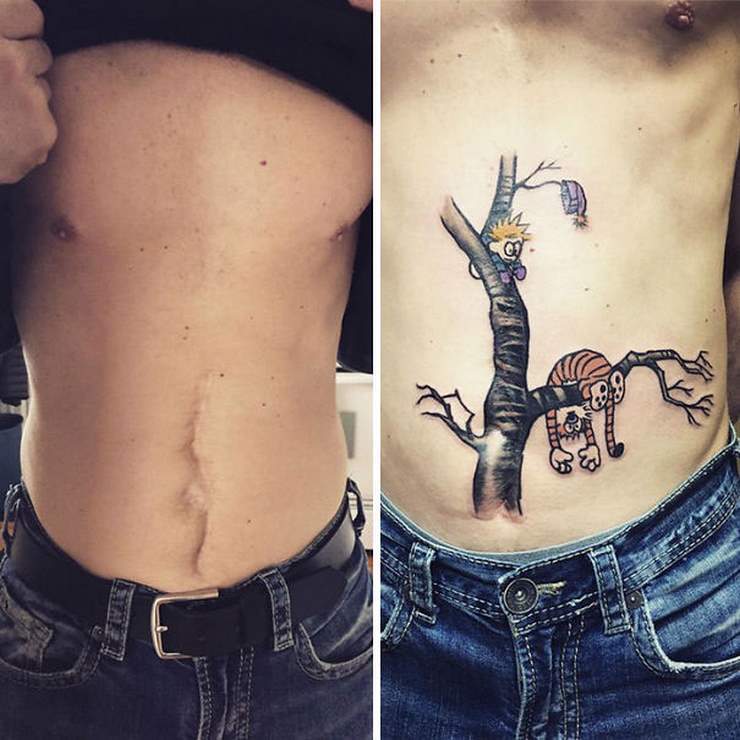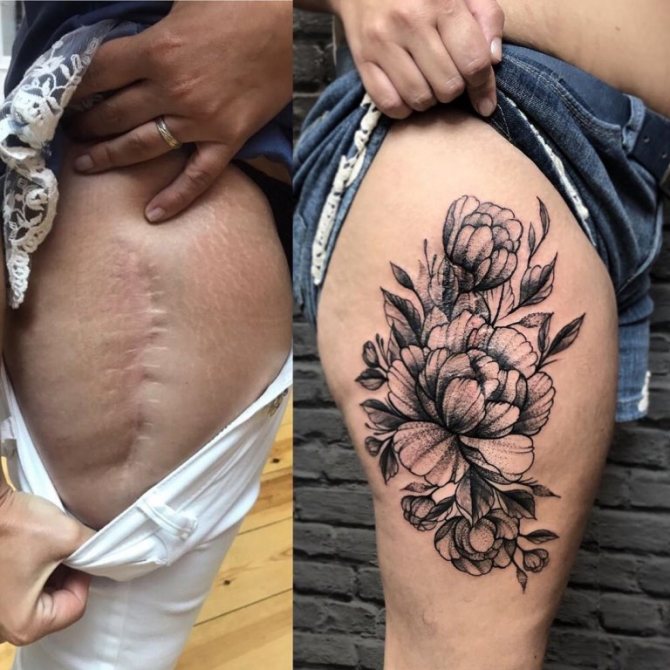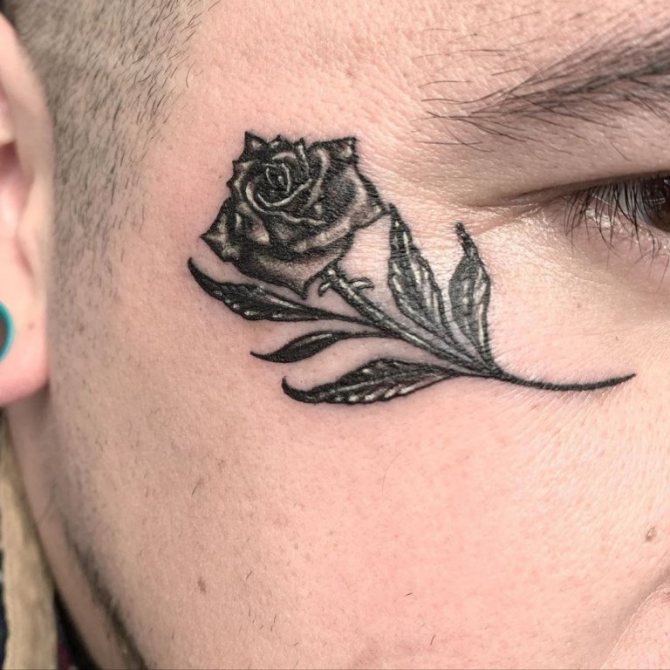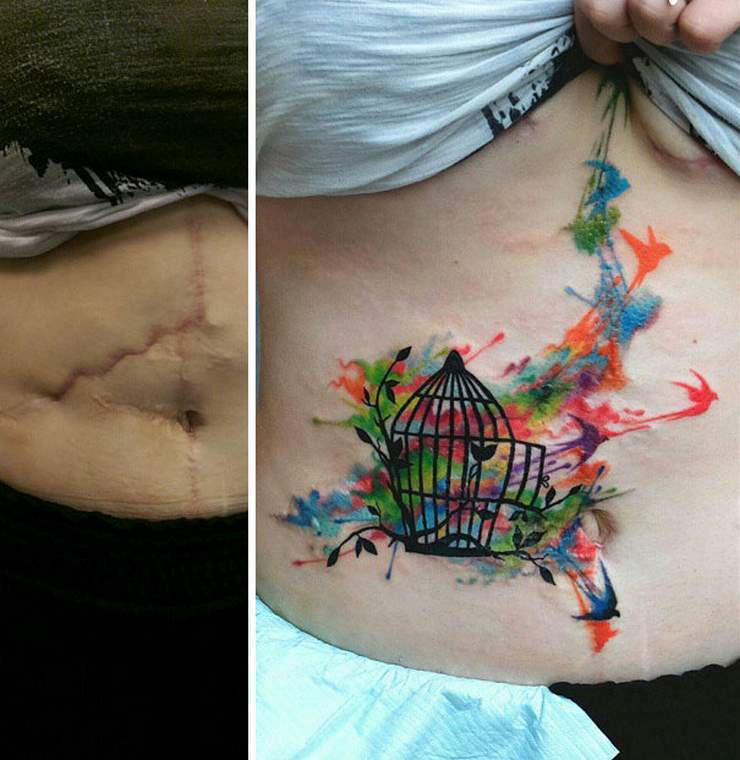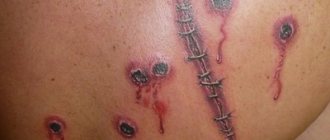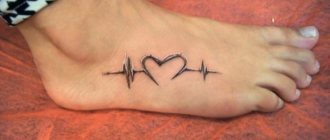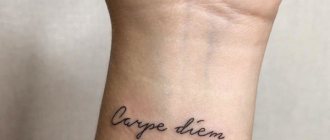Tattoo - a modern type of body art, with which men and women decorate their bodies, express their individuality and originality. However, there are people who use tattoos not only as a decor for their body, but also as the only way out of the situation. Tattoos on scars are often an option that saves the former attractiveness after injuries or scars. To hide the scars and make a beautiful tattoo, you need to properly select the sketch of the figure, as well as learn whether you can apply a tattoo in principle.
Scar formation
The process of tissue regeneration after surgery to remove appendicitis takes a long time. First, the process of epithelialization begins, which lasts about a week.
Then, collagen and elastin begin to be actively produced, which help the body to form the site of the scar after appendicitis.
In terms of appearance, the following categories can be noted:
- The first month - Dense red areas of cuts, sometimes giving off a blue hue;
- The next three months - The process of habituation, when the scar becomes even and pale;
- The period from the fifth to the sixth month. The dermis becomes close to its normal hue, although far from the original dermis appearance before the intervention. Only after passing this stage can you think about getting a tattoo on the appendicitis scar.
How does the scar after surgery look like
It is accepted to distinguish 4 types of scars that can form on the skin after surgery.
These are:
- Normotrophic scar - thin, pale, flat;
- hypertrophic scar - excess connective connective tissue;
- keloid scar - red, convex;
- atrophic scar - concave, below skin level.
Scar in normal healing.
At first, the red bands look inflamed and swollen, then they are covered with fresh crusts, which gradually come off, exposing new dermis. Usually at this stage, girls and some men begin to consider scar correction with a tattoo.
Location
The location of the scar after appendicitis will largely depend on the results of the surgery to remove the appendix.
In some people it will be two points after laparoscopy, which are difficult to see with a simple look, in others, most of the scar looks like a diagonal stripe next to the right pelvic bone protruding. In complicated cases, the sutures can girdle the entire lower abdomen.
Options for its correction
Once the appendicitis has been excised and the scar has scarred, correction can begin.
The most common methods include:
- foundation - quick, but ineffective method;
- surgery - a heavy load on the body, possible consequences;
- dermabrasion - removal of the scar after appendicitis removal by laser;
- Cryodestruction - removal of the scar after appendicitis removal with liquid nitrogen;
- Tattooing - a simple and aesthetically beautiful way to make the body better.
When you can get a tattoo on the scar
Tattooing a tattoo on the scar after appendicitis removal can be quite a dangerous procedure if the rules are not followed.
For the procedure should be selected by a competent master, who can competently work out a sketch of the tattoo, taking into account the characteristics of the scar, and perform the tattoo design in compliance with all sanitary norms.
Before visiting a tattoo parlor, it is worth getting a recommendation from your doctor, who may express wishes about touching certain areas on the skin. For example, protruding scars can react badly to the paint and contribute to the onset of inflammation.
Doctors recommend that you begin tattooing at the site of surgery to remove appendicitis no sooner than 6-12 months have passed.
Contraindications and possible complications
The list of main contraindications:
- Unhealed scars and scars,
- Susceptibility to strong allergic skin manifestations After contact with anesthetics or other substances used in the tattooing procedure,
- Pregnancy and breast-feeding,
- Presence of infectious skin diseases,
- Serious chronic diseases in the acute stage.Including insulin-dependent diabetes, asthma, and any oncologic processes,
- The presence of or predisposition to keloid scars,
- Injection of BotoxInjection of Botox, fillers in the place of a future tattoo,
- The presence of freckles, moles, or other tumors, including those of a benign nature,
- Conducting therapy with systemic medications - Corticosteroids, antibiotics, anticoagulants, immunomodulators.
With a properly performed procedure, sterility of the instruments, the proper level of skill of the master, in the vast majority of cases no complications are formed. Potentially possible negative consequences include:
- Secondary bacterial infection of the skin,
- Allergic manifestations with rashes.
Care for a fresh scar
Although many people believe that care after appendicitis surgery will not improve the appearance of scars, this opinion is wrong. Routine hygienic procedures can be insufficient to provide meaningful therapeutic treatment.
For better scarring and subsequent aesthetic appearance, therapeutic regular care should be performed.
Tips for healing the scar at home
Systematic scar care will help avoid inflammation and lead to a body that looks almost as good as before after appendix removal.
Care tips:
- Irritants should be eliminated - Avoid rough washcloths, hard, rubbing underwear, or physical activities that can cause injury;
- Apply a silicone pad and use gels, which speed up healing and help tissues form properly;
- Creams such as Contraktubex, Mederm, Strataderm will help blood circulate better by warming the surface, creating a massage effect. Blood will not stagnate and tissues will heal faster. It is better to lubricate the rumen by courses of 14 days with an interval of a similar period;
- Wearing a tight bandage (if indicated by the doctor) to avoid discomfort when moving, compaction in the area of the scar.
Scar treatment options
Only your doctor can tell you the right treatment for your scars. The type of scar you have will determine whether certain measures are appropriate to help your body heal. Whichever procedure the patient prefers, the doctor always has the last word.
- Physiotherapy. The systematic influence of physical therapy is useful for the body as a whole, it will help to avoid negative consequences, but it will not significantly affect the appearance.
- Ointments and gels. Regular rubbing will help the seam to scar quickly, maintaining elasticity and preventing the formation of irregularities.
- Hormone therapy. Special medications are injected into the scar area to help soften and flatten the tissue. Some treating physicians may suggest special medications to help smooth out the skin in the early stages of healing.
- Chemical peels. A harsh chemical peel is only indicated after the skin has fully healed. It won't help get rid of the scar, but it will significantly soften the skin, making it smoother. Systematic repetition will produce results.
- Laser resurfacing. This method is considered the gentlest and has minimal contraindications. The laser makes the scar almost inconspicuous.
- Plastic surgery. A radical way of removing visible damage to the body allows you to get rid of the memories of trauma, to make the skin smooth. The only disadvantage is the repeated anesthesia and its effect on the body.
Covering burn scars with a tattoo
A burn is damage to the epidermis and soft tissues of the human body under the influence of high temperature, chemical substances. Grade 1 pathology leaves no problems after skin recovery. Strictures, scars, other formations are typical for complicated burns of the 2nd degree of severity, as well as damages of the 3rd degree of severity.
Tattoo masking skin imperfections after burns can be applied only after the person has fully recovered, has been discharged from the hospital, and the epidermis has stabilized. The choice of a specific pattern, the specificity of its location, other parameters depends on the localization of the problem, its size, the type of scar, other objective factors.
Types of scars and compatibility with tattoos
- Atrophic scars Considered to be the ideal place for a tattoo. They look like flat white squares of dermis that are sunken deeper than the underlying dermis. These include stretch marks, burns or acne scars.
- Normotrophic scars Have one surface in common with the underlying dermis and are white in color. Such scars are concealed by a tattoo.
- Hypertrophic scars For - dark, protruding above the underlying skin. Such scars hide the tattoo with difficulty. It will require painstaking work of the master and considerable money.
- Keloid scars - The most negative types of scars. Scars do not begin to appear on the body until several months after appendicitis surgery. They are mobile, growing and changing on a regular basis. Tattooing is not allowed on these types of dermal lesions.
Will the scar from a C-section or appendicitis scar be noticeable after a tattoo?
Whether the scar will be noticeable or not depends only on two things: the type of scar, the professionalism of the master. If the postoperative scar is atrophic or normotrophic, when it does not protrude above the surface of the skin, does not have a pronounced shade, then most likely the tattoo will help to hide the defect on the skin.
If the scar is of a convex shape, its color significantly differs from the skin, to save the situation will be able to tattoo "situational", when the picture is chosen so that the protrusion of the scar harmoniously fit into it, as shown in the photo below.
Pay attention! Hypertrophic, keloid scars cannot be completely masked.
They will be visible on closer inspection. The tattoo in this case helps to give the scar an interesting interpretation, but does not remove the problem completely. It is possible that in a few years the scar will become a little more noticeable, as the pigment will fade. Sometimes it is still better to resort to a scar excision procedure after surgery rather than masking it.
Choice of sketch
In tattoo salons, you can choose a drawing from a variety of options. It can be a feather, a lightning bolt, a beautiful flower, which girls love to choose, or an inscription. It is worth orienting on the shape of your scar, listening to the recommendations of the master.
What girls choose
Girls often choose delicate, feminine designs for tattoos.
The ranking of the most popular tattoos to cover scars include:
- drawing of feathers;
- butterflies;
- flowers;
- ornaments;
- animals;
- cute inscriptions.
What men choose
Men are usually more conservative, so their choice falls on:
- symbolic inscriptions for tattoos;
- Menacing beasts for tattoos;
- Weapon themes in tattoos.
How you can cover the scars with a tattoo - tips from the masters
Once the decision has been made to create a drawing on the scar after appendicitis, discuss all possible options for a tattoo picture with the master. By virtue of his experience, he will help to decide which tattoo will look more favorable, hiding the damaged skin.
In some cases, applying a colored tattoo may be impossible for aesthetic, psychological, medical or religious reasons. Even in this case, masters offer help by applying an invisible design.
Such tattoo is identical to the color of the dermis and may only stand out when tanned, completely overlapping the scar.
When is it possible to get a tattoo?
Performing a tattoo procedure is possible under the following circumstances:
- The presence of normotrophic or atrophic lesions. The possibility of tattooing for hypertrophic scars is considered individually,
- Final healing. The damaged tissues must be in the post-removal stage. Major diseases and negative conditions that led to the problem - absent,
- Absence of serious diseases.. We are talking about diabetes mellitus, massive herpes infection, acute skin diseases, including infectious nature, other pathologies of this kind.
Scars in men and women - the differences
The only difference in the healing of scars in men and girls, is the speed of formation of new tissue. In men, due to the production of testosterone, the healing process is faster.
Although the tissues heal quickly, men try to engage in physical work more quickly. Such recklessness threatens serious complications and poor tissue fusion.
Pros and cons of getting a scar tattoo on a girl
Not every girl will dare to create a tattoo even in the scar area.
Pros include:
- The aesthetically beautiful appearance of the tattoo design on the scar after removal of appendicitis;
- Complete elimination of negative memories.
The disadvantages include tattoos on the scar after appendicitis removal:
- Negative perception by the older generation or others;
- loss of appearance of the tattoo in the process of aging of the dermis and its sagging.
Is it possible to get a tattoo on the scar?
Many people turn to masters of tattooing with a request to do a tattoo on the scar. But not everyone thinks to consult with a doctor beforehand. In fact, most scars may well be covered by a tattoo. But sometimes such an initiative can be, to put it mildly, not healthy.
If you want to hide the ugly scar on the body under the tattoo, it is worth first to contact a dermatologist or surgeon. The doctor will determine the type of scar and tell you how safe and effective the tattooing will be in this case.
